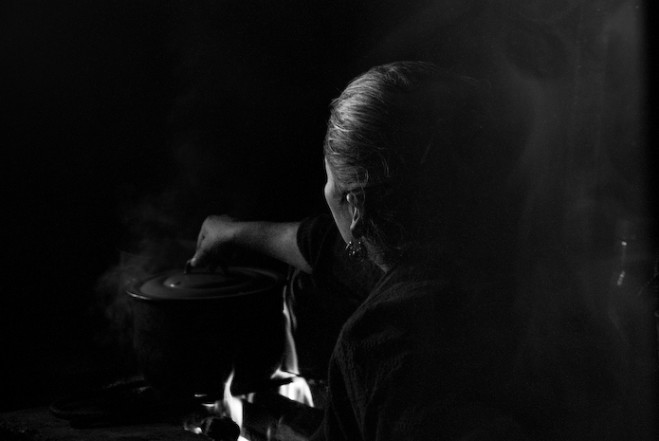by Sara Bissen [ x ]
Istanbul feels like metal, but tastes like tear gas. In the city itself, I find it safe to say there’s more gas in the air today than there was during the 2013 Gezi protests. We may not see the manifestation in its most obvious form, but we can rest assured it’s there.
From what I saw in 2013, much of the Gezi uprising stemmed from the Lefebvrian concept of Contradictory Space that highlights not only the exploitation of labor—but the exploitation of land.[1]
As valid as the reality and expectations of Gezi were, I have a hard time trusting the authenticity of a largely middle-class secular uprising. Especially one that uses barricades as spectacle,[2] where the purpose becomes urban centric enclosure on a piece of land that has since been forgotten (except for the sake of nostalgia). Forgotten for many reasons, but the point is—it’s forgotten by many. Perhaps the metallic city relates to a land dispossession that started long before the manifestation of bodies. Long before the manifestation of gas used to disperse those bodies, yet one that is able to disperse within the nostalgia itself—where the taste is even more acidic than before.
Land highlights the disassociation of social relations that a staged unity rarely fails to conceal. However this is a disassociation I rarely see among my Kurdish friends, who although forcibly displaced, hold more land together than among anyone in any place I’ve ever seen in Istanbul.

Chicazanga, San Andrés Itzapa, Chimaltenango, Guatemala. 2009. Photo by Sara Bissen.
The people of Guatemala know the exploitation of land and labor.
The process of taking down ex-military commander Otto Pérez Molina, today’s President of Guatemala, involves confronting the same man who was once in charge of the scorched earth campaign and massacre of Mayas during the 1980s under military dictator Ríos Montt.[3] The process to take down Pérez Molina’s government doesn’t taste like tear gas—as far as I can tell. In fact, Guatemala reminds me of smoke. Smoke, burning from the houses to cook dinner; burning from the roadside to protest. For me, I remember the smell of fire from the homes themselves—from the firewood itself.
When I left Guatemala in November 2011, Pérez Molina had just been elected. Essentially a symbol of genocide erasure showing that having the Partido Patriota’s “Mano Dura” in power might bring stability to a violent and poverty-inflicted country—indicating the severity of the situation in Guatemala where collective genocidal memory could be negotiated for collective, yet most likely individual, security today. When I returned in February 2013, the insecurity and violence had worsened under another failed governance—but the people had remained strong (and even strengthened) in contrast to Pérez Molina. I noticed what had remained especially strong was the overwhelming majority of land-less Maya.
Guatemala’s rural population is 49%, whereas Turkey’s is 29%.[4] Guatemala’s overt political manifestations (since April 2015) may be taking place in a plaza in front of the National Palace, but unlike Istanbul’s “urban uprising”—what’s happening in Guatemala is not void of (or distanced from) the rural. Although I’m not there today, I’m positive rural indigenous Mayas are in the square, where 27 August worked in tandem with more than 37 roadblocks that had been set up for two days across rural Guatemala.[5]
Barricades for purpose versus barricades “for looks.”
Without the rural, the marginal, the peripheral, whatever we call it—the urban is nothing more than “structure” as spectacle. But as the structure is taken down piece by piece—we choose how to fill it.[6]
Journalist Allan Nairn said that “if the souls of Rios Montt’s and Pérez Molina’s victims could descend to earth in corporeal form … they would more than fill the Plaza de la Constitución”.[7]
Guatemala is in stillness, whereas Istanbul is in silence—because stillness is when the ground takes root.
Footnotes:
[1] Lefebvre, H. (1973). The production of space. Cambridge: Blackwell Publishing.
[2] Bissen, S. (2013). [Photography of barricades from Gezi Park protests on June 4, 2013, within overarching body of work on land dispossession]. Istanbul. Retrieved from http://sarabissen.com/portfolio/istanbul/
[3] For more on the current and historical Guatemalan context, see interview with journalist Allan Nairn in Democracy Now! Goodman, A. (2015, August, 27). Guatemala president faces arrest as business interests and U.S. scramble to contain uprising. Democracy Now! Retrieved from http://m.democracynow.org/stories/15460
[4] Based on 2014 World Bank estimates and United Nations, World Urbanization Prospects, referring to people living in rural areas and calculated as the difference between the total population and a defined urban population. The World Bank. (2015). Percentage of population in rural areas (in % of total population) [Data file]. Retrieved from http://data.worldbank.org/indicator/SP.RUR.TOTL.ZS
[5] (2015, August, 28). Massive protests call for president to resign as corruption scandal hits Guatemala. VICE News. Retrieved from https://news.vice.com/article/massive-protests-call-for-president-to-resign-as-corruption-scandal-hits-guatemala. Further, Paco from Hijos Guatemala stated that “the city was the last focus of resistance that began with the indigenous peoples of Guatemala at the beginning of this government (of Otto Pérez Molina).” Abbott, J. (2015, May, 2015). Guatemala: Popular protests challenge corruption and the political establishment. The Fifth Column. Retrieved from http://thefifthcolumnnews.com/2015/05/guatemala-popular-protests-challenge-corruption-and-the-political-establishment/
[6] (L. Cohen-Shapiro of Applied Psychology for Yogis, personal communication, 2015). Dialogue and continued research based on the theory and practice of stillness.
[7] A Nairn. (2015, August, 30). [Twitter entry]. Retrieved from https://twitter.com/allannairn14/status/637768716055240704 and https://twitter.com/allannairn14/status/637769366046576640
[ x ] The Ruralist Body.
This article has been originally published here August 31 2015. We are grateful to the Author for the authorization to repost it.